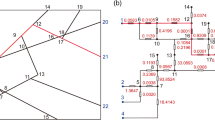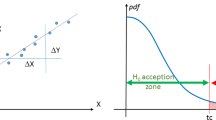Abstract
Two methods, both using data from fixed-interval-length hydraulic tests and geological mapping on different scales, have been utilised to estimate transmissivity distributions of individual fractures. Individual fracture properties are of importance in estimating transport of water and solutes; they influence the spreading of grout when sealing tunnels. One of the methods is non-parametric, while the other is based on combinatorics and the multiplication principle. The study verified the usefulness of both methods for estimating the probability of conductive and non-conductive fractures, and the transmissivity distributions. Data for estimating transmissivity distributions originate from flow logging of a borehole in Sweden. Fracture frequency data are from core logging and images using a borehole image processing system (BIPS). Estimated transmissivity distributions, based on flow log data from 3-m sections (test scale length, L: 3 m, and step length, dL: 3 m), were compared with transmissivities obtained directly from detailed, overlapping flow logging which identify individual conductive fractures (test scale, L: 0.5 m, step length, dL: 0.1 m). The latter data are considered to be an acceptable approximation of the individual fracture transmissivities; the agreement, compared with the calculated transmissivity distributions based on 3-m section data, is good for both methods.
Résumé
Deux méthodes ont été testées afin d’estimer la distribution des transmissivités de fractures unitaires; toutes deux utilisent des données issues de tests hydrauliques effectués à intervalles réguliers et de cartographies géologiques à plusieurs échelles. La connaissance des propriétés des fractures unitaires est importante pour estimer le transport d’eau et de solutés; elles influencent en outre l’étalement du coulis lors du scellement des tunnels. La première méthode est non-paramétrique, et la seconde repose sur l’analyse combinatoire et le principe de multiplication. Cette étude a vérifié l’utilité des deux méthodes pour estimer la probabilité d’occurrence de fractures conductrices et non-conductrices, et la distribution des transmissivités. Les distributions des transmissivités ont été estimées à partir de diagraphies effectuées sur un forage situé en Suède. Les densités de fracturation proviennent de carottages et d’imagerie BIPS (Borehole Image Processing System). Les distributions estimées des transmissivités, basées sur des diagraphies de flux effectuées sur des sections de 3 m (échelle du test L:3 m; pas dL:3 m), ont été comparées aux transmissivités obtenues sur des diagraphies de flux détaillées et se chevauchant, identifiant les fractures conductrices unitaires (échelle du test L: 0.5 m ; pas dL: 0.1 m). Il est admis que ces dernières données représentent une approximation satisfaisante des transmissivités des fractures unitaires; les deux méthodes sont en accord avec les distributions des transmissivités calculées à partir des données acquises sur des sections de 3 m.
Resumen
Se han utilizado dos métodos, ambos procesando datos de pruebas hidráulicas de longitud e intervalo fijo y mapas geológicos en distintas escalas, para estimar las distribuciones de transmisividad de fracturas individuales. Las propiedades de fracturas individuales son de importancia para estimar el transporte de agua y solutos; las propiedades influyen en la propagación de lechada al sellar túneles. Uno de los métodos es no paramétrico mientras que el otro se basa en el principio de multiplicación y combinatorio. El estudio verifica la utilidad de ambos métodos para estimar la probabilidad de fracturas conductivas y no conductivas y las distribuciones de transmisividad. Los datos para estimar las distribuciones de transmisividad se originan del registro de flujo de un pozo en Suecia. Los datos de frecuencia de fracturas provienen de registros de núcleo e imágenes usando un Sistema de Procesamiento de Imágenes de Pozo (BIPS). Se compararon las distribuciones estimadas de transmisividad basadas en datos del registro de flujo en secciones de 3 m (longitud de escala de la prueba L: 3 m, y escalón de longitud dL: 3 m), con transmisividades obtenidas directamente de registros detallados de flujo superpuesto el cual identifica fracturas conductivas individuales (escala de la prueba, L: 0.5 m, escalón de longitud, dL: 0.1 m). Los últimos datos se consideran una aproximación aceptable de las transmisividades de fracturas individuales; la consistencia, comparada con las distribuciones de transmisividad calculada basadas en datos de sección de 3 m, es buena para ambos métodos.




Similar content being viewed by others
References
Andersson J, Berglund J, Follin S, Hakami E, Halvorson J, Hermanson J, Laaksoharju M, Rhén I, Wahlgren C-H (2002) Testing the methodology for site descriptive modelling application for the Laxemar area. SKB Technical Report R-02-19, SKB, Stockholm, Sweden
Axelsson C-L, Jonsson E-K, Geier J, Dershowitz W (1990) Discrete fracture modelling. SKB Progress Report 25-89-21, SKB, Stockholm, Sweden
Carlsten S, Stråhle A, Ludvigson J-E (2001) Conductive fracture mapping: a study on the correlation between borehole TV- and radar images and difference flow logging results in borehole KLX02. SKB Report R-01-48, SKB, Stockholm, Sweden
Dershowitz W, Lee G, Geier J, Foxford T, LaPointe P, Thomas A (1998) User documentation, FracMan interactive discrete feature data analysis, geometric modelling, and exploration simulation. Version 2.6, Golder Associates, Seattle, WA
Eriksson M (2002) Grouting field experiment at the Äspö Hard Rock Laboratory. Tunn Undergr Space Technol 17(3):287–293
Fransson Å (2001) Characterisation of a fractured rock mass for a grouting field test. Tunn Undergr Space Technol 16(4):331–339
Fransson Å (2002) Nonparametric method for transmissivity distributions along boreholes. Ground Water 40(2):201–204
Fransson Å, Rhén I (2002) Estimating probability of conductive fractures using borehole data: a case study. Paper presented at the XXXII IAH & ALHSUD Congress 2002, Mar del Plata, Argentina, 21–25 October 2002
Gustafson G, Stille H (1996) Prediction of groutability from grout properties and hydrogeological data. Tunn Undergr Space Technol 11(3):325–332
Ludvigson J-E, Hansson K, Rouhiainen P (2002) Methodology study of Posiva difference flow meter in borehole KLX02 at Laxemar. SKB Report R-01-52, SKB, Stockholm, Sweden
Muldoon MA, Simo JA, Bradbury KR (2001) Correlation of hydraulic conductivity with stratigraphy in a fractured-dolomite aquifer, northeastern Wisconsin, USA. Hydrogeol J 9:570–583
Öhman J, Niemi A, Tsang C-F (2005) Probabilistic estimation of fracture transmissivity from wellbore hydraulic data accounting for depth-dependent anisotropic rock stress. Int J Rock Mech Min Sci 42:793–804
Osnes JD, Winberg A, Andersson J-E (1988) Analysis of well test data: application of probabilistic models to infer hydraulic properties of fractures. Topical Report RSI-0338. RE/SPEC, Rapid City, SD
Paillet FL (1998) Flow modeling and permeability estimation using borehole flow logs in heterogeneous fractured formations. Water Resour Res 34(5):997–1010
Paillet FL, Pedler WH (1996) Integrated borehole logging methods for wellhead protection applications. Eng Geol 42:155–165
Rhén I, Bäckblom G, Gustafson G, Stanfors R, Wikberg P (1997) Äspö HRL: geoscientific evaluation 1997/2: results from pre-investigations and detailed site characterization. Summary report. SKB Technical Report-97-03, SKB, Stockholm, Sweden
Rouhiainen P (2000) Difference flow measurements in borehole KLX02 at Laxemar. Äspö Hard Rock Laboratory. SKB IPR 01-06, SKB, Stockholm, Sweden
Snow DT (1970) The frequency and apertures of fractures in rock. Int J Rock Mech Min Sci 7:23–40
Stanfors R, Rhén I, Tullborg E-L, Wikberg P (1999) Overview of geological and hydrogeological conditions of the Äspö Hard Rock Laboratory site. Appl Geochem 14:819–834
Talbot CJ, Sirat M (2001) Stress control of hydraulic conductivity in fracture-saturated Swedish bedrock. Eng Geol 61:145–153
Acknowledgements
The author wishes to thank the Swedish Nuclear Fuel and Waste Management Company (SKB) and the Swedish Research Council for Environment, Agricultural Sciences and Spatial Planning (Formas) for their financial support. The valuable advice of Professor Gunnar Gustafson, Ann Emmelin, Lora Sharp McQueen and the reviewers and the editors is especially appreciated.
Author information
Authors and Affiliations
Corresponding author
Rights and permissions
About this article
Cite this article
Fransson, Å. A case study to verify methods for estimating transmissivity distributions along boreholes. Hydrogeol J 15, 307–313 (2007). https://doi.org/10.1007/s10040-006-0141-1
Received:
Accepted:
Published:
Issue Date:
DOI: https://doi.org/10.1007/s10040-006-0141-1




